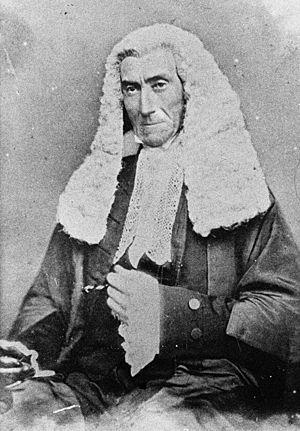John Plunkett facts for kids
Quick facts for kids
John Plunkett
|
|
|---|---|
 |
|
| 5th Attorney-General of New South Wales | |
| In office 17 September 1836 – 5 June 1856 |
|
| Preceded by | John Kinchela |
| Succeeded by | William Manning |
| In office 25 August 1865 – 21 January 1866 |
|
| Preceded by | John Darvall QC |
| Succeeded by | James Martin QC |
| 2nd Solicitor-General of New South Wales | |
| In office 14 June 1832 – 16 September 1836 |
|
| Preceded by | Edward MacDowell |
| Succeeded by | William à Beckett |
| Personal details | |
| Born |
John Hubert Plunkett
June 1802 Mount Plunkett, County Roscommon, Ireland |
| Died | 9 May 1869 East Melbourne, Victoria, Australia |
| Alma mater | Trinity College Dublin |
| Occupation | Politician |
John Hubert Plunkett (born June 1802 – died 9 May 1869) was an important legal and political figure in early Australia. He served as the Attorney-General of New South Wales and was a member of both the Legislative Council and the Legislative Assembly.
Plunkett is especially remembered for his brave actions in seeking justice for the victims of the Myall Creek Massacre in 1838. In this terrible event, 28 Aboriginal people were killed. Plunkett worked hard to make sure the people responsible were brought to trial. Seven of them were found guilty and punished.
Contents
John Plunkett's Life and Legacy
Early Years in Ireland
John Hubert Plunkett was born in June 1802 in Mount Plunkett, County Roscommon, Ireland. He was one of twins. His parents were George and Eileen Plunkett.
He went to Trinity College Dublin in 1819 and finished his studies in 1824. After that, he became a lawyer in Ireland in 1826 and later in England. He worked as a lawyer in Ireland for several years. He also supported Catholic Emancipation, which was a movement to give more rights to Catholics.
A Legal Career in Australia
In 1831, John Plunkett was chosen to be the Solicitor-General of New South Wales. He arrived in Sydney in June 1832. At that time, the Attorney-General, John Kinchela, had hearing problems, so Plunkett often had to do most of his duties.
In 1836, Plunkett became the Attorney-General himself. He worked with Governor Richard Bourke to create new laws for churches and schools.
Fighting for Fairness
Plunkett strongly believed that everyone should be treated equally under the law. He made sure that former convicts, known as emancipists, could serve on juries. He also extended legal protections to convicts and servants.
Most importantly, Plunkett tried to protect Aboriginal people. He famously charged the people involved in the Myall Creek massacre with murder. Even though the first trial failed, he tried again, and this time, some of the accused were found guilty.
Important Legal Changes
Plunkett also helped pass the Church Building Act in 1836. This law made all major Christian religions, like Anglicans, Catholics, and Presbyterians, equal in the eyes of the law. Before this, the Church of England had special status.
In 1847, Plunkett became a member of the Executive Council. In 1848, when the public school system started, he became the chairman of the Board of Education. He stopped being Attorney-General in 1856 and received a pension. He was also made a Queen's Counsel (QC), which is a special title for experienced lawyers. He was the first lawyer in New South Wales to receive this honor.
A Role in Government
In 1856, John Plunkett was elected to the Legislative Assembly. He represented two areas, Bathurst and Argyle. He later resigned from the Assembly and was appointed to the Legislative Council. He was even elected as its President.
Plunkett also served as Attorney-General again from 1865 to 1866. He was known for being a strong supporter of civil and religious freedom in the colony. He also believed in giving more people the right to vote.
Later Life and Influence
From 1865 to 1867, John Plunkett was the vice-chancellor of the University of Sydney. This meant he helped lead the university.
He spent his last two years mostly in Melbourne because of his wife's health. He passed away on 9 May 1869 in East Melbourne. His body was brought back to Sydney and buried in the old Devonshire Street Cemetery.
Plunkett also wrote several important legal books. These included The Australian Magistrate; a Guide to the Duties of a Justice of the Peace and The Magistrate's Pocket Book. These books helped guide people working in the legal system.

